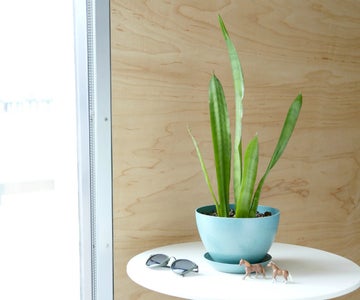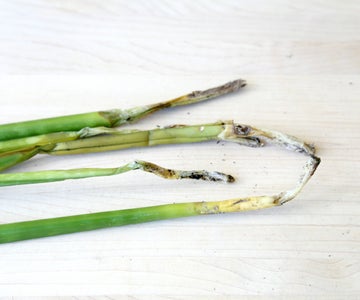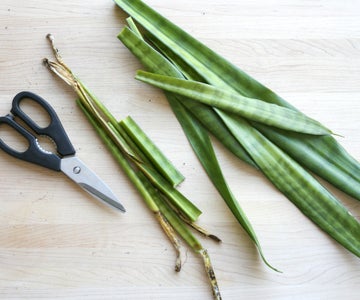The African spear plant, also known as sansevieria cylindrica, is a popular houseplant known for its upright, cylindrical leaves that can grow up to 6 feet tall Native to Angola and South Africa, this low-maintenance succulent thrives indoors with minimal care. However, African spear plants can develop a rotting problem if overwatered or planted in soil with poor drainage Let’s look at the causes of rot in the African spear plant and what you can do to prevent and treat it.
What Causes Rot in the African Spear Plant?
The main cause of rot in sansevieria plants is overwatering. These succulents store water in their thick, fleshy leaves and prefer their soil to dry out between waterings. Too much moisture around the roots leads to decay. Other factors that can contribute to rot include:
-
Poor drainage – Dense, heavy potting mixes that retain moisture can lead to wet soil and cause root rot. African spear plants need lightweight, porous soil that drains well.
-
Overcrowding – When planted too densely, the leaves remain wet for prolonged periods, providing the perfect environment for fungal diseases.
-
Cold weather – Sansevieria growth slows down in winter Watering too often during colder months keeps the soil wet and encourages rot,
-
Poor air circulation – Stagnant air prevents the soil from drying out properly. Good airflow around the plant is essential.
-
Overfertilization – Excess fertilizer salts in the soil can damage roots and leave them prone to infection.
-
Container size – An overly large pot that the spear plant’s roots don’t fully occupy can lead to wet soil. Choose a suitably sized container.
Preventing Rot in Your African Spear Plant
The best way to prevent rot is to provide your African spear plant with proper growing conditions. Here are some tips:
-
Water deeply but infrequently. Allow the soil to dry out between waterings. In warmer months, you may need to water once a week. In winter, once every 2-3 weeks is sufficient. The lower leaves will get wrinkly when it needs water.
-
Use fast-draining potting mix. A cactus/succulent soil blend or a homemade mix of equal parts potting soil, coarse sand, perlite and peat moss works well.
-
Plant in containers with drainage holes. Make sure excess water can easily drain away from the roots. Avoid non-draining pots.
-
Give plenty of sunlight. These plants thrive in bright, direct light. Rotate the pot regularly so all sides get sun exposure.
-
Allow good air circulation. Keep some distance between plants and avoid overcrowding them. Gently blowing a fan over the leaves also helps.
-
Don’t over-fertilize. Fertilize just 2-3 times during the active growing season. Slow-release fertilizer pellets work great.
-
Monitor soil moisture. Check the soil before watering. The top few inches should be dry. Use your finger or a moisture probe.
-
Choose the right pot size. Select a container that’s only slightly larger than the root ball to avoid soggy soil. Re-pot when roots fill the pot.
Treating Rot in Your African Spear Plant
If you notice signs of rot such as yellowing foliage, dark water-soaked spots on leaves or a foul odor from the base, don’t panic! Catching it early allows you to take action and save your plant. Here are some treatment tips:
1. Remove Affected Plant Parts
Prune off any mushy, severely damaged leaves using sterilized scissors. Also, trim off rotting roots. This prevents the infection from spreading further.
2. Re-pot in Fresh Soil
Gently remove the plant and wash off as much old soil as possible. Repot it in a sterile potting mix, preferably one amended with sand or perlite. Make sure the container has drainage.
3. Let the Soil Dry Out
Allow the soil to completely dry before watering again. This gives the roots a chance to heal. Don’t water on a set schedule. Wait until the soil is totally dry first.
4. Apply a Fungicide
Dusting the base of the plant with a fungicide labeled for botrytis encourages healthy root growth. Always follow product instructions carefully.
5. Reduce Watering Frequency
Going forward, adjust your watering habits. Stick your finger in the soil to gauge moisture before watering. Or use a moisture meter if unsure.
6. Apply Organic Fertilizer
Feed with organic fertilizer to nourish the plant while it recovers. Worm castings or compost tea work wonderfully. Avoid chemical fertilizers as they can burn roots.
7. Increase Sunlight Exposure
Place the sansevieria in the sunniest location possible. Strong light helps dry out the leaves and soil. Rotate the pot regularly for even sun coverage.
8. Monitor Progress
Keep an eye on new growth. Healthy green shoots and leaves indicate the plant is recovering well! Remove any new brown mushy growth promptly.
Caring For Your African Spear Plant
- Site: Bright, indirect light. Rotate plant for even sun exposure.
- Water: Allow soil to dry between waterings. Reduce frequency in winter.
- Soil: Fast-draining cactus mix. Amend with perlite or sand.
- Container: Pot with drainage holes. Terra cotta breathes well.
- Fertilizer: Use organic fertilizer at 1/2 strength during growing season.
- Pests: Mealybugs, spider mites. Wipe with insecticidal soap.
- Pruning: Remove dead leaves. Prune leggy growth for shape.
- Propagation: Division of rhizomes or leaf cuttings.
With the right care, your African spear sansevieria can thrive for years, rewarding you with its striking vertical foliage! Just be mindful not to overwater and provide this succulent beauty with plenty of light and well-draining soil. A healthy spear plant is less prone to rot.
:max_bytes(150000):strip_icc()/grow-sansevieria-cylindrica-1902732-06-eaa2a39580bc490d9b00fbd2943fd794.jpg)
Introduction: Save a Rotting Snake Plant

I have a confession to make: I really over loved my Snake Plant. Like REEAAALLLYY over loved it. And by over loved, I mean of course, over watered. : ( If this has happened to you, dont despair! Here is one way to try and save face, along with your rotting plant friend.
Sansevieria trifasciata, a.k.a. Snake Plant or Mother-in-laws-tongue, is an extremely hardy plant. (Which makes it all the more embarrassing to have melted mine.) They are very much like succulents in that they dont require very much water and can handle most environments, with the exception of extreme cold.
When they get really droopy, as mine did – trying to tell me it wasnt happy, it will almost always mean too much water. There are many other factors that go into a healthy Snake Plant, but Im going to focus on good ol root rot and how to try and save as much of the plant as possible.

- a clean pot & saucer- appropriate for the size of your leaves*
- utility scissors or garden sheers
- perlite
- peat moss or vermiculite
- container to mix the two soil ingredients
- big wooden spoon
*I used a 6″ plastic pot, but if you have it, a clay pot is even better as it offers more aeration for this desert loving plant.
Step 2: Make a Clean Cut!



In order to say goodbye to the rotten ends of your leaves, cut the bottoms off well above the melty and yellowed ends. You want to make a straight cut across in what looks to be a healthy section.
I chose to leave my leaves as long as possible to maintain the look of a plant while they try to take root. If you prefer to ere on the side of caution, cut them even shorter.
NOTE: There is always a chance that a fungus or bacteria has entered the plants system as a result of the rot and theres no way to know if thats happened, but I always think its worth a try to save it. If it doesnt work, then Ill throw it out and get a new one.
Let your cut leaves sit for 24 hours to callus over before moving on to the next step. If you have any cinnamon in stock, you can also sprinkle a bit on the ends as its an anti-fungal. (I was out!)
Dracaena Angolensis (African Spear Plant/Cylindrical Snake Plant) Care and Propagation! #Dracaena
FAQ
Can I save a snake plant that has root rot?
How do you prevent plant rot?
Why is my African spear plant dying?
How often should you water an African spear?
